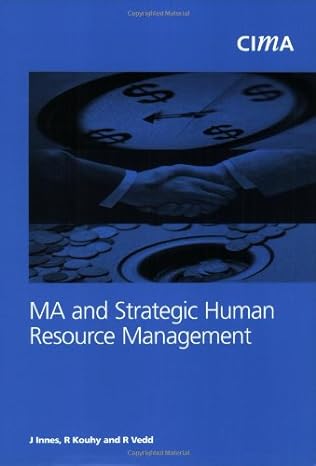Question
4-42 Allocation of manufacturing overhead and disposition of overallocation or underallocation. (SMA, heavily adapted) Nicole Limited is a company that produces machinery to customer order.
4-42 Allocation of manufacturing overhead and disposition of overallocation or underallocation.
(SMA, heavily adapted) Nicole Limited is a company that produces machinery to customer
order. Its job-costing system (using normal costing) has two direct cost categories
(direct materials and direct manufacturing labour) and one indirect cost pool (manufacturing
overhead, allocated using a budgeted rate based on direct manufacturing labour costs). The
budget for 2013 was:
Direct manufacturing labour $630,000
Manufacturing overhead $441,000
At the end of 2013, two jobs were incomplete: No. 1768B (total direct manufacturing labour
costs were $15,000) and No. 1819C (total direct manufacturing labour costs were $48,000).
Machine time totalled 318 hours for No. 1768B and 654 hours for No. 1819C. Direct materials
issued to No. 1768B amounted to $30,600. Direct materials for No. 1819C came to
$56,800.
Total charges to the Manufacturing Overhead Control account for the year were
$406,200. Direct manufacturing labour charges made to all jobs were $650,000, representing
25,000 direct manufacturing labour-hours (DMLH).
There were no beginning inventories. In addition to the ending work-in-process, the
ending finished goods showed a balance of $204,500 (including a direct manufacturing labour
cost component of $60,000). Sales for 2013 totalled $3,124,000, cost of goods sold was
$2,200,000, and marketing costs were $523,900.
Nicole prices on a cost-plus basis. It currently uses a guideline of cost plus 40% of cost.
REQUIRED
1. Prepare a detailed schedule showing the ending balances in the inventories and cost of goods
sold (before considering any underallocated or overallocated manufacturing overhead).
Show also the manufacturing overhead allocated to these ending balances.
2. Compute the underallocated or overallocated manufacturing overhead for 2013.
3. Prorate the amount computed in requirement 2 on the basis of:
a. The ending balances (before proration) of work-in-process, finished goods, and cost of
goods sold.
b. The allocated overhead amount (before proration) in the ending balances of workin-
process, finished goods, and cost of goods sold.
4. Assume that Nicole decides to immediately write off to Cost of Goods Sold any underallocated
or overallocated manufacturing overhead. Will operating income be higher or lower
than the operating income that would have resulted from the proration in requirements 3(a)
and 3(b)?
.
Step by Step Solution
There are 3 Steps involved in it
Step: 1

Get Instant Access to Expert-Tailored Solutions
See step-by-step solutions with expert insights and AI powered tools for academic success
Step: 2

Step: 3

Ace Your Homework with AI
Get the answers you need in no time with our AI-driven, step-by-step assistance
Get Started


